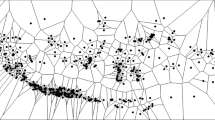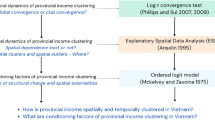Abstract
This study examines the intrastate income disparities in Odisha by evaluating the σ-convergence and absolute and conditional β-convergence in income per capita across the districts of Odisha over the time period from 1995–1996 to 2010–2011. Employing measures of σ-convergence (Gini coefficient and Theil inequality index) and β-convergence (absolute and conditional), it examines not only the intrastate income disparities but also if the poorer districts have been able to catch up with the richer ones. The results of σ-convergence indicate an increase in intrastate income disparities in Odisha since the beginning of the new century, which is largely attributed to within-division inequality. Ironically, Odisha has witnessed a rise in regional disparities in its period of boom and vice versa, indicating thereby that growth fails to create “trickledown effect.” The absolute β-convergence measure proves income divergence across the districts of Odisha. However, if the factors causing regional disparities like economic structure, institutional quality and spillover effects are controlled for, there is conditional convergence. Since the income divergence across districts is due to variations in their steady states, targeting investment toward promoting farm incomes in districts having lower steady-state levels may improve growth performance while reducing regional imbalance. Measures to ensure institutional quality and create greater inter-district interdependence through removal of mobility barriers may help the poorer districts catch up with the richer ones. Targeted efforts to ensure laggard districts to grow faster than the developed ones will help Odisha realize regional inequality narrowing effects within a reasonable time.

Source: Estimated from the data acquired from the DES, GoO

Source: Estimated from the data acquired from the DES, GoO

Source: Estimated from the data acquired from the DES, GoO

Source: Estimated from the data acquired from the DES, GoO

Source: Estimated from the data acquired from the DES, GoO

Source: Estimated from the data acquired from the DES, GoO

Source: Estimated from the data acquired from the DES, GoO
Similar content being viewed by others
Notes
According to 2004-05 constant prices.
According to 2011-12 constant prices.
References
Artelaris P, Petrakos G (2016) Intraregional spatial inequalities and regional income level in the European Union: beyond the inverted-U hypothesis. Int Reg Sci Rev 39(3):291–317
Aschauer DA (1989) Is public expenditure productive? J Monet Econ 23(2):177–200
Azzoni CR (2001) Economic growth and regional income inequality in Brazil. Ann Reg Sci 35(1):133–152
Baltagi B (2005) Econometric analysis of panel data, 3rd edn. Wiley, Chichester
Barro RJ (1991) Economic growth in a cross section of countries. Q J Econ 106(2):407–443
Barro RJ, Sala-i-Martin X (1995) Economic growth, 1st edn. McGraw-Hill, New York
Bourguignon F (1979) Decomposable income inequality measures. Econometrica 47(4):901–920
Breusch TS, Pagan AR (1980) The Lagrange multiplier test and its applications to model specification in econometrics. Rev Econ Stud 47(1):239–253
Brun JF, Combes JL, Renard MF (2002) Are there spillover effects between coastal and noncoastal regions in China? China Econ Rev 13(2–3):161–169
Census of India (2011) Census of India 2011: provisional population totals-India data sheet. Office of the Registrar General and Census Commissioner, India, New Delhi: Government of India, Ministry of Home Affairs. http://www.census2011.co.in/scheduled-tribes.php. Accessed 17 Feb 2018
Cherodian R, Thirlwall AP (2015) Regional disparities in per capita income in India: convergence or divergence? J Post Keynes Econ 37(3):384–407
Chong A, Calderon C (2000) Institutional quality and income distribution. Econ Dev Cult Change 48(4):761–786
Datt G, Ravallion M (1998) Why have some Indian states done better than others at reducing rural poverty? Economica 65(257):17–38
Fedderke JW, Perkins P, Luiz JM (2006) Infrastructural investment in long-run economic growth: South Africa 1875–2001. World Dev 34(6):1037–1059
Friedman J, Alonso W (1964) Regional development as a policy issue. In: Friedman J, Alonso W (eds) Regional development and planning: a reader. MIT Press, Cambridge
Ghosh M (2012) Regional economic growth and inequality in India during the pre-and post-reform periods. Oxf Dev Stud 40(2):190–212
Ghosh B, De P (1998) Role of infrastructure in regional development: a study over the plan period. Econ Polit Wkly 33(47/48):3039–3048
Government of Odisha (2015) Odisha economic survey 2014–15. Planning and Convergence Department, Odisha, Bhubaneswar
Government of Odisha (2019) Odisha economic survey 2018–19. Planning and Convergence Department, Odisha, Bhubaneswar
Hausman JA (1978) Specification tests in econometrics. Econometrica 46(6):1251–1271
Hayami Y (1997) Development economics. Oxford University Press, Oxford
Islam N (1995) Growth empirics: a panel data approach. Q J Econ 110(4):1127–1170
Islam N (2004) New growth theories: what is in there for developing countries? J Dev Areas 38(1):171–212
Kaiser HF (1958) The varimax criterion for analytic rotation in factor analysis. Psychometrika 23(3):187–200
Kalirajan K, Akita T (2002) Institutions and interregional inequalities in India: finding a link using Hayami’s thesis and convergence hypothesis. Indian Econ J 49(4):47–59
Kalirajan K, Shand RT, Bhide S (2010) Strategies for achieving sustained high economic growth: the case of Indian states. SAGE Publications India, New Delhi
Kanbur R, Venables AJ (2005) Spatial inequality and development. In: Kanbur R, Venables AJ (eds) Spatial inequality and development. Oxford University Press, New York, pp 3–11
Kar S, Sakthivel S (2006) Regional divergence in India during the era of liberalization: a sectoral decomposition. J Dev Areas 40(1):65–79
Knack S, Keefer P (1995) Institutions and economic performance: cross-country tests using alternative institutional measures. Econ Polit 7(3):207–227
Knight JB, Sabot RH (1983) Educational expansion and the Kuznets effect. Am Econ Rev 73(5):1132–1136
Kumar S (2013) Crime and economic growth: evidence from India (MPRA paper no. 48794). Munich Personal RePEc Archive, Germany: Munich University. https://mpra.ub.uni-muenchen.de/48794/1/MPRA_paper_48794.pdf. Accessed 19 Feb 2018
Lessmann C, Seidel A (2017) Regional inequality, convergence, and its determinants: a view from outer space. Eur Econ Rev 92(February):110–132
Manjunath S, Kannan E (2017) Effects of rural infrastructure on agricultural development: a district level analysis in Karnataka, India. J Infrastruct Dev 9(2):1–14
Mankiw NG, Romer D, Weil DN (1992) A contribution to the empirics of economic growth. Q J Econ 107(2):407–437
Mathur A (1983) Regional development and income disparities in India: a sectoral analysis. Econ Dev Cult Change 31(3):475–505
Mishra A, Mishra V (2017) Is there conditional convergence in the per capita incomes of BIMAROU states in India? Economic modelling, (in press, corrected proof). https://www.sciencedirect.com/science/article/pii/S0264999317312634. Accessed 18 Feb 2018. https://doi.org/10.1016/j.econmod.2017.08.017
Mishra A, Mishra V (2018) Re-examination of convergence hypothesis among Indian states in panel stationarity testing framework with structural breaks. Appl Econ 50(3):268–286
Moulton BR, Randolph WC (1989) Alternative tests of the error components model. Econometrica 57(3):685–693
Myrdal G (1957) Economic theory and underdeveloped regions. Gerald Duckworth, London
Nagraj R, Varoudakis A, Véganzonès MA (2000) Long-run growth trends and convergence across Indian states. J Int Dev 12(1):45–70
Peri G (2004) Socio-cultural variables and economic success: evidence from Italian provinces 1951–1991. Top Macroecon 4(1):1–34
Pfaffermayr M (2009) Conditional β-and σ-convergence in space: a maximum likelihood approach. Reg Sci Urban Econ 39(1):63–78
Rajan RG (2013) Report of the committee for evolving a composite development index of states, New Delhi: Government of India, Ministry of Finance. http://finmin.nic.in/sites/default/files/Report_CompDevState.pdf. Accessed 29 Jan 2018
Rao MG, Shand RT, Kalirajan KP (1999) Convergence of incomes across Indian states: a divergent view. Econ Polit Wkly 34(13):769–778
Raychaudhuri A, Haldar SK (2009) An investigation into the inter-district disparity in West Bengal, 1991–2005. Econ Polit Wkly 44(26/27):258–263
Rey SJ (2001) Spatial analysis of regional income inequality. Department of Geography, San Diego State University, San Diego (working paper)
Romer PM (1990) Endogenous technological change. J Polit Econ 98(5, Part 2):S71–S102
Sahoo P, Dash RK (2009) Infrastructure development and economic growth in India. J Asia Pac Econ 14(4):351–365
Sala-i-Martin XX (1996) Regional cohesion: evidence and theories of regional growth and convergence. Eur Econ Rev 40(6):1325–1352
Sanga P, Shaban A (2017) Regional divergence and inequalities in India. Econ Polit Wkly 52(1):102–110
Sarap K, Sahu PP (2016) Emerging trends in cropping pattern, crop diversification, and agricultural productivity. In: Nayak PB, Panda SC, Pattanaik PK (eds) The economy of Odisha: a profile. Oxford University Press, New Delhi
Shaban A (2006) Regional structures, growth and convergence of income in Maharashtra. Econ Polit Wkly 41(18):1803–1815
Shorrocks AF (1980) The class of additively decomposable inequality measures. Econometrica 48(3):613–625
Sofi AA, Durai SRS (2015) Income disparities across Indian states: evidence from Kuznets curve and shift analysis. Int J Dev Issue 14(2):171–187
Sofi AA, Durai SRS (2017) Income convergence in India: evidence from nonparametric panel data. J Econ Stud 44(3):400–411
Terrasi M (1999) Convergence and divergence across Italian regions. Ann Reg Sci 33(4):491–510
Theil H (1967) Economics and information theory. North-Holland, Amsterdam
Trivedi K (2002) Regional convergence and catch-up in India between 1960 and 1992, UK: Nuffield College. http://www.nuffield.ox.ac.uk/Economics/Papers/2003/W1/convergencewp1.pdf. Accessed 18 Feb 2018
United Nations (UN) 2005 Crime and development in Africa. UN Office of Drug and Crime, Vienna, Austria: United Nations. https://www.unodc.org/pdf/African_report.pdf. Accessed 18 Feb 2018
United Nations Development Programme (UNDP) (2005) Human development report. UNDP, New York
United Nations Development Programme (UNDP) (2019) The sustainable development goals report 2019. UNDP, New York
Walsh JA, O’Kelly ME (1979) An information theoretic approach to measurement of spatial inequality. Econ Soc Rev 10(4):267–286
Wei YD (1999) Regional inequality in China. Prog Hum Geogr 23(1):49–59
World Bank (2006) Crime, violence and economic development in Brazil: elements for effective public policy (report no. 36525). Washington, DC: The World Bank. http://pdba.georgetown.edu/Security/citizensecurity/brazil/documents/docworldbank.pdf. Accessed 18 Feb 2018
Funding
This research has not been funded by any external sources.
Author information
Authors and Affiliations
Corresponding author
Ethics declarations
Conflict of interest
The authors declare that they have no conflict of interest.
Additional information
Publisher's Note
Springer Nature remains neutral with regard to jurisdictional claims in published maps and institutional affiliations.
Rights and permissions
About this article
Cite this article
Mahakur, P.K., Nayak, N.C. An investigation of intrastate income disparities and regional convergence in Odisha. J. Soc. Econ. Dev. 21, 288–308 (2019). https://doi.org/10.1007/s40847-019-00086-w
Published:
Issue Date:
DOI: https://doi.org/10.1007/s40847-019-00086-w




